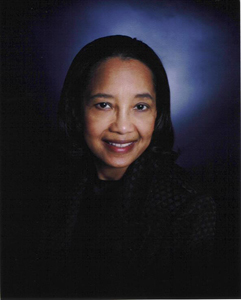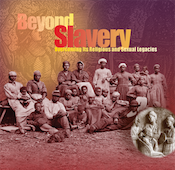Beyond Slavery
Explore the Conference
Explore the Conference by Subject
Slavery in Christian, Jewish, and Muslim Scripture and Religious Law
Christianity, Religion of the Slaveholders and the Enslaved
Sexual Assault and Exploitation Under U.S. Slavery and Jim Crow
How Slavery Has Shaped Our Understandings of Marriage and Friendship
Slavery, Violence, and the State
Beyond Slavery:
Overcoming Its Religious
& Sexual Legacy
Sexual Assault and Exploitation Under U.S. Slavery and Jim Crow
Speakers at the "Beyond Slavery" conference spoke on the following topics related to sexual violence in the era of slavery and Jim Crow.
In Search of Sally Hemings: Slavery and Sexual Agency in the History of the United States, by Mia Bay
Practices of Sexual Terrorism in the Reconstruction South, by Lisa Cardyn
Breaking the Silence: Sexual Hypocrisies from Thomas Jefferson to Strom Thurmond, by Catherine Clinton
Reparations for Slavery, by Adrienne Davis
"He said he would give us some flowers": Sexual Violations, Girls, and the Law in the Antebellum South, by Wilma King
The Paradox of Silence and Display: Sexual Violation of Enslaved Women and Contemporary Contradictions in Black Female Sexuality, by Dorothy Roberts
Mia Bay: In Search of Sally Hemings: Slavery and Sexual Agency in the History of the United States
 The story of Sally Hemings, Thomas Jefferson's enslaved lover and mother of six of his children, has gone from scandal to romance to the subject of historical and scientific investigation. All of these approaches misrepresent the liaison between the Founding Father and his female possession because they ignore the sexual exploitation and family losses inscribed across the Hemings family's history and across the history of American slavery. Even discussions that heroically attempt to locate Hemings' own choices, desires and pleasures are doomed because they require us to separate Sally Hemings the woman from Sally Hemings the enslaved woman. That separation was simply inconceivable during her lifetime. Within the context of slavery, property, and power, Hemings had no rights. She had no right to say "no" when she was 13 or 14 and her sexual relationship with Jefferson began, and had no right to say "no" when her children were sold off with the rest of Jefferson's property after his death. Imagining this relationship as a romance reveals our longing for a sexual ethics that includes mutual choice, respect and consent. Jefferson himself may have provided us with the most straightforward and accurate insight into his relationship with Hemings when he described slavery as "a perpetual exercise of the most boisterous passions and the most unremitting despotism on the one part, and degrading submissions on the other."
The story of Sally Hemings, Thomas Jefferson's enslaved lover and mother of six of his children, has gone from scandal to romance to the subject of historical and scientific investigation. All of these approaches misrepresent the liaison between the Founding Father and his female possession because they ignore the sexual exploitation and family losses inscribed across the Hemings family's history and across the history of American slavery. Even discussions that heroically attempt to locate Hemings' own choices, desires and pleasures are doomed because they require us to separate Sally Hemings the woman from Sally Hemings the enslaved woman. That separation was simply inconceivable during her lifetime. Within the context of slavery, property, and power, Hemings had no rights. She had no right to say "no" when she was 13 or 14 and her sexual relationship with Jefferson began, and had no right to say "no" when her children were sold off with the rest of Jefferson's property after his death. Imagining this relationship as a romance reveals our longing for a sexual ethics that includes mutual choice, respect and consent. Jefferson himself may have provided us with the most straightforward and accurate insight into his relationship with Hemings when he described slavery as "a perpetual exercise of the most boisterous passions and the most unremitting despotism on the one part, and degrading submissions on the other."
Watch Presentation
Lisa Cardyn: Practices of Sexual Terrorism in the Reconstruction South
Not long ago audiences worldwide were shocked to learn of the grotesque tortures perpetrated by American military and civilian personnel on inmates at Iraq's infamous Abu Ghraib prison. Especially provocative was the powerful photographic and testimonial evidence revealing the extent to which those involved relied on sexualized techniques to dominate their captives. Curiously, at a time when we as a nation are more acutely aware than ever of out vulnerability to terrorist attacks from abroad, recognition of this abiding and insidious domestic peril is slight at best and appreciation of its historical antecedents practically nonexistent. Yet from the European "conquest" of Native America to the staggering rates of child molestation in the present day, examples of homegrown sexual terrorism are abundant. None, however, better exemplifies its profound consequences and enduring implications than the white supremacist klans that emerged in the predominantly Christian South from the ashes of the U.S. Civil War. These groups employed disparate methods-most prominently whipping, rape, lynching, genital torture and mutilation-to wield sex as an instrument of terror designed to traumatize a despised population into submission. Assailing freed people and their allies on the basis of alleged sexual, social, or political transgressions, klansmen thus endeavored to deny victims' humanity, thwart their individual and collective aspirations, and shackle African Americans to a status that was strikingly reminiscent of bondage. Analogous to its deployment in more recent contexts, sexual violence systematically applied proved a remarkably efficient means of achieving its intended result: in this instance, the reenshrinement of white male supremacy. Much as the trauma of slavery affected those well beyond its immediate grasp, so too have the ramifications of klan terror persisted, contributing in subtle yet significant ways to the perpetuation of racial and gender hierarchy.
Watch Presentation
Catherine Clinton: Breaking the Silence: Sexual Hypocrisies from Thomas Jefferson to Strom Thurmond
 Slavery in the United States depended on segregationist ideology and white supremacist views. Yet interracial liaisons between white male slaveowners and enslaved women and girls were not rare. Indeed, they often resulted in children and thus what we can call "shadow families". These shadow families were an institution, unacknowledged but evident, within the American South, both during and long after slavery. Statesmen as eminent as Thomas Jefferson and Strom Thurmond are now known to have had shadow families. These relationships expose the contradictions within racial separatism and the American ideals of sexual purity and Christian virtue. Exploring this pattern of interracial sexual liaisons broadens our understanding of what slavery meant to its participants and what their legacy is for us today. Examining the larger context of slavery allows us to see that it was about much more than the expropriation of labor. We can recognize its daunting consequences for family and kinship, both during and after slavery's reign.
Slavery in the United States depended on segregationist ideology and white supremacist views. Yet interracial liaisons between white male slaveowners and enslaved women and girls were not rare. Indeed, they often resulted in children and thus what we can call "shadow families". These shadow families were an institution, unacknowledged but evident, within the American South, both during and long after slavery. Statesmen as eminent as Thomas Jefferson and Strom Thurmond are now known to have had shadow families. These relationships expose the contradictions within racial separatism and the American ideals of sexual purity and Christian virtue. Exploring this pattern of interracial sexual liaisons broadens our understanding of what slavery meant to its participants and what their legacy is for us today. Examining the larger context of slavery allows us to see that it was about much more than the expropriation of labor. We can recognize its daunting consequences for family and kinship, both during and after slavery's reign.
Watch Presentation
Adrienne Davis: Reparations for Slavery
 African Americas have tried to obtain reparations for slavery since the nineteenth century. Many leaders supported them throughout the twentieth century, including W.E.B. Du Bois and Queen Mother Audrey Moore. Taken together, the systematic political repression, economic discrimination, racial abuses of the criminal system (including blacks as both victims and defendants), brutal rending of black families, forced health experiments while denying basic healthcare, repression of literacy, and access to education warrant recognition and monetary reparation. Paying reparations would make us partners with others worldwide who condemn slavery and be a step toward making blacks real citizens in America. However, even with all of the recent writing on reparations, we still have not really grappled with the question of sexual reparations. Religious communities are particularly well poised to exercise leadership on this question. Religious leaders and institutions are especially powerful over matters regarding women, families, and sexuality. Yet, historically, mainstream religion, with few exceptions, refused to condemn, or even address or recognize, sexual abuses under slavery. Even in the face of public pro-slavery defenses of slavery, religious leaders remained largely silent, supporting slavery and its sexual injustices. The contemporary reparations debate offers religious institutions a second chance. They can exercise leadership in bringing reparations to public attention and also draw on their moral influence in the area of sexuality to insist especially that slavery's sexual injustices receive equal attention.
African Americas have tried to obtain reparations for slavery since the nineteenth century. Many leaders supported them throughout the twentieth century, including W.E.B. Du Bois and Queen Mother Audrey Moore. Taken together, the systematic political repression, economic discrimination, racial abuses of the criminal system (including blacks as both victims and defendants), brutal rending of black families, forced health experiments while denying basic healthcare, repression of literacy, and access to education warrant recognition and monetary reparation. Paying reparations would make us partners with others worldwide who condemn slavery and be a step toward making blacks real citizens in America. However, even with all of the recent writing on reparations, we still have not really grappled with the question of sexual reparations. Religious communities are particularly well poised to exercise leadership on this question. Religious leaders and institutions are especially powerful over matters regarding women, families, and sexuality. Yet, historically, mainstream religion, with few exceptions, refused to condemn, or even address or recognize, sexual abuses under slavery. Even in the face of public pro-slavery defenses of slavery, religious leaders remained largely silent, supporting slavery and its sexual injustices. The contemporary reparations debate offers religious institutions a second chance. They can exercise leadership in bringing reparations to public attention and also draw on their moral influence in the area of sexuality to insist especially that slavery's sexual injustices receive equal attention.
Watch Presentation
Wilma King: "He said he would give us some flowers": Sexual Violations, Girls, and the Law in the Antebellum South
 Antebellum court cases involving enslaved women and girls give us remarkable insight into attitudes toward sexual violence and women who responded to abuse with violence. It turns out that we may need to reconsider some assumptions. Enslaved women sometimes did fight back against rape by their owners; women did stand up to men and act independently from them; white women did not always turn their heads away from the exploitation that white men visited upon the enslaved; and enslaved victims were sometimes treated on a par with white victims, especially when they were children. Even more remarkable is the way that these cases allow us to hear the voices and begin to understand the experiences of enslaved women and girls. One particularly compelling case, Commonwealth v. Ned (1859), involves an enslaved middle-aged man charged with raping six-year-old Betty Gordon and nine-year-old Eunice Thompson. Although Betty was enslaved and Eunice was not, the justice of the peace in Fredericksburg, Virginia, joined their cases to charge Ned. Both children were considered entitled to legal redress, and Ned was found guilty. In this case, Betty tells us in her own words how Ned lured her into the cemetery where he worked with the promise of flowers, biscuits, and a glimpse of little mockingbirds; how he gave her something sweet to drink; how he threw her down and assaulted her; and how little of what happened the child was able to understand, other than the pain. We also hear the voice of Eunice, and of both children's caregivers-black and white-who not only confronted Ned but also insisted on bringing charges against him. In addition to the evidence regarding consent and force, community values, economic constraints, and the status of both the defendants and plaintiffs influenced judicial proceedings. These findings are meaningful for contemporary society in that they challenge conventional wisdom claiming whites and the court ignored the sexual abuse claims of black women, and that perpetrators went unpunished. Moreover it is evident that unheralded women and men sought justice for victims of rape in selected cases while others moved forward to offer legal protection from future violations.
Antebellum court cases involving enslaved women and girls give us remarkable insight into attitudes toward sexual violence and women who responded to abuse with violence. It turns out that we may need to reconsider some assumptions. Enslaved women sometimes did fight back against rape by their owners; women did stand up to men and act independently from them; white women did not always turn their heads away from the exploitation that white men visited upon the enslaved; and enslaved victims were sometimes treated on a par with white victims, especially when they were children. Even more remarkable is the way that these cases allow us to hear the voices and begin to understand the experiences of enslaved women and girls. One particularly compelling case, Commonwealth v. Ned (1859), involves an enslaved middle-aged man charged with raping six-year-old Betty Gordon and nine-year-old Eunice Thompson. Although Betty was enslaved and Eunice was not, the justice of the peace in Fredericksburg, Virginia, joined their cases to charge Ned. Both children were considered entitled to legal redress, and Ned was found guilty. In this case, Betty tells us in her own words how Ned lured her into the cemetery where he worked with the promise of flowers, biscuits, and a glimpse of little mockingbirds; how he gave her something sweet to drink; how he threw her down and assaulted her; and how little of what happened the child was able to understand, other than the pain. We also hear the voice of Eunice, and of both children's caregivers-black and white-who not only confronted Ned but also insisted on bringing charges against him. In addition to the evidence regarding consent and force, community values, economic constraints, and the status of both the defendants and plaintiffs influenced judicial proceedings. These findings are meaningful for contemporary society in that they challenge conventional wisdom claiming whites and the court ignored the sexual abuse claims of black women, and that perpetrators went unpunished. Moreover it is evident that unheralded women and men sought justice for victims of rape in selected cases while others moved forward to offer legal protection from future violations.
Watch Presentation
Dorothy Roberts: The Paradox of Silence and Display: Sexual Violation of Enslaved Women and Contemporary Contradictions in Black Female Sexuality
 Contemporary American black women have two choices when it comes to expressing their sexuality: they can accept the dominant values that delight in placing black female bodies on display, or they can turn in the opposite direction and submit to the requirements of respectability that conceal sexual abuse and silence sexual desire. There is the role model of Jezebel, and that of Mammy. This dual straitjacket dates back to the sexual violation of enslaved women and girls that began early in our history as a nation, and the slaveholding mythology that legitimized such violation. The ideology of slavery painted black women as licentious in order to excuse white sexual abuse, and as animalistic to explain their enforced subjugation. In response, after Emancipation the black community developed an ideal of womanhood that depended on asexuality for respectability. These extremes have left a gaping void in the cultural terms needed for black women to freely and publicly define their own sexual identities today. Filling this void requires overthrowing racist sexual stereotypes and changing the unjust social policies, institutions, and conditions that reinforce them.
Contemporary American black women have two choices when it comes to expressing their sexuality: they can accept the dominant values that delight in placing black female bodies on display, or they can turn in the opposite direction and submit to the requirements of respectability that conceal sexual abuse and silence sexual desire. There is the role model of Jezebel, and that of Mammy. This dual straitjacket dates back to the sexual violation of enslaved women and girls that began early in our history as a nation, and the slaveholding mythology that legitimized such violation. The ideology of slavery painted black women as licentious in order to excuse white sexual abuse, and as animalistic to explain their enforced subjugation. In response, after Emancipation the black community developed an ideal of womanhood that depended on asexuality for respectability. These extremes have left a gaping void in the cultural terms needed for black women to freely and publicly define their own sexual identities today. Filling this void requires overthrowing racist sexual stereotypes and changing the unjust social policies, institutions, and conditions that reinforce them.
Watch Presentation
This page is part of the webpages dedicated to the conference, "Beyond Slavery: Overcoming Its Religious and Sexual Legacy," held on October 15-16, 2006. It was sponsored by the Feminist Sexual Ethics Project in the Near Eastern and Judaic Studies Department at Brandeis University.
